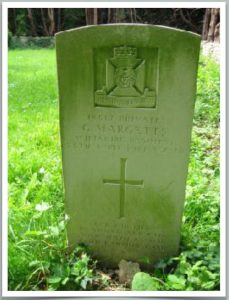2nd Battalion, Duke of Edinburgh’s (Wiltshire Regiment)

Unfortunately, no Army Service Record has survived for George Margetts but a good insight into his service has survived in a letter from one of his officers, sent following his death.
George Edwin Margetts was born at Kingstone Lisle, Berkshire in 1895 and he was one of 10 children born to Albert Margetts (1865-1926), a farm labourer and his wife Sarah Elizabeth (née Miles; 1868-1926). One of the ten children died in 1906.
According to the 1901 Census the family lived at Eaton Hastings, near Farringdon, where Alfred was a cattle man on a farm. By 1911 they had moved to South Farm, Fernham, Faringdon then in Berkshire (now Oxfordshire).
In the absence of any service record the exact date when George enlisted is not known but all of the indications are that he volunteered early in the war and according to the Soldiers Died in the Great War volumes he enlisted at Devizes.
According to his Medal Rolls Index Card (MIC), he was first posted to the Western Front on 1 June 1915 and joined the 2nd Battalion of the Wiltshire Regiment, then part of 21 Brigade, 7 Division. In December 1915 21 Brigade transferred to 30 Division.
Following his death, the North Wilts Herald published the following on 8 June 1917 under the heading ‘Officer’s Tribute To Dead Soldier’ :
Writing from a hospital bed to the parents of the late George Margetts, Lieut. Alan Wilson, of the Wilts Regiment, says:
I was very sorry indeed to see your son’s name in the casualty list of May 28th as ‘died of wounds’. He was wounded by the same shell that hit me and although he was badly hit the doctor at the casualty clearing station assured me that he would pull through alright. Your son was a very fine soldier and one of the few survivors of Festubert, Givenchy and Loos, of whom the Wiltshires were very proud. They were men whom one could treat in everything, and were soldiers – not pressed men. George was my batman for the last five months, and I had therefore soldiered with him long enough to know his sterling worth. I do not know how to express adequately my sympathy for you, for I know how empty mere words are in face of such great sorrow, having lost a brother myself last July. If he is buried in England, I should be grateful if you could let me know the name of the cemetery, so that I may arrange for a wreath to be placed on his grave in order in some way show the high estimation in which all his friends of —— (censored) Company,
—– (censored) Wilts, held this very gallant soldier.
The letter gives some welcome detail of George’s Army service and if the date of his posting to the Western Front shown on his MIC is correct, he would therefore not have participated in the Battle of Festubert (15 to 25 May 1915) but may well have been part of a draft of men to replace casualties sustained in the battle.
He could well have been in action at Givenchy (15 to 16 June 1915) and almost certainly was in the Battle of Loos (25 September to 8 October 1915), where the battalion sustained 200 casualties amongst Other Ranks on the opening day. On 19 December 1915, 21 Brigade switched to 30 Division and the 2nd Wilts saw distinguished action during the Somme Offensive of 1916: presumably Private Margetts came through this unscathed.
Examination of Lieutenant A Wilson’s Officers’ File at the National Archives (WO339/77740), indicates that he was wounded in the left thigh by a small shell fragment at Mercantel (south of Arras) on 1 April 1917.
It would appear that the actual date of wounding was 31 March 1917, as this entry appears in the battalion War Diary: Quiet day. A little hostile shelling in the evening. 2Lt A Wilson and 4 OR
wounded. Private George Margetts was almost certainly one of the four Other Ranks.
Private Margetts would have been taken to a casualty clearing station and was then passed down the treatment line to a base hospital on the coast and then sent back to England.
According to his entry in the Register of Soldiers’ Effects he died in hospital on 25 April 1917 and the burial records for Down Ampney Parish Church show that he died at the Military Hospital at York. He was aged 22. His burial took place on 28 April 1917 and his grave is now marked by a standard CWGC headstone.
George had a brother, Alfred John, who also served with the Wiltshire Regiment. His number was 18518 and therefore he and George must have enlisted together on the same day.
Alfred was killed in action with the 1st Battalion of the Wiltshires, in the Ypres Salient on 3 September 1915, aged 18. He has no known grave and is commemorated on the Menin Gate. Both George and he are named on the Down Ampney War memorial.
Researched by Graham Adams 1 January 2021 (Revised 30 September 2021)
